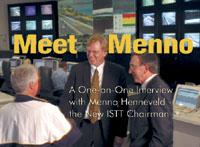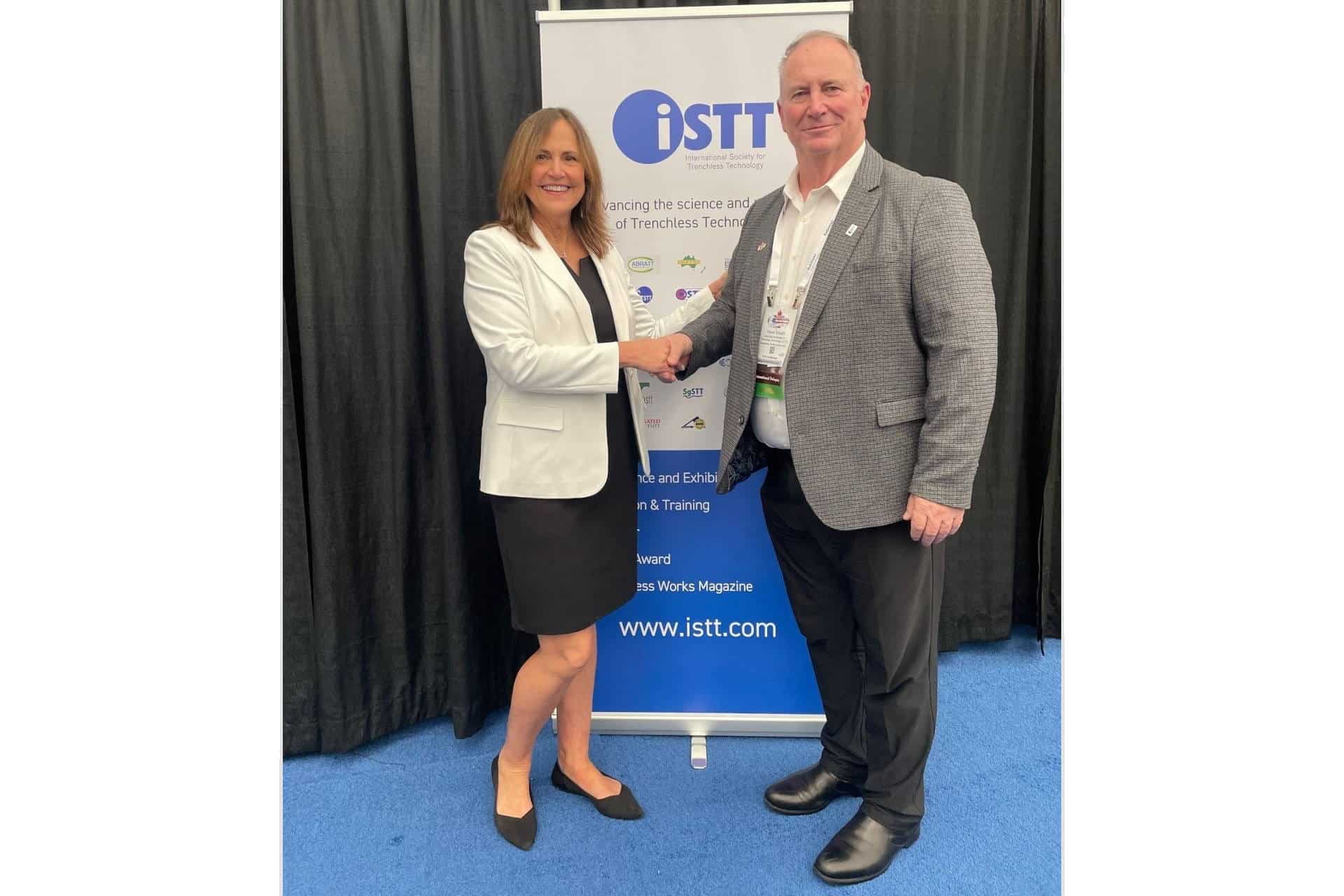Meet Menno
 Menno Henneveld became the new chairman of the International Society forTrenchless Technology (ISTT) in September 2005 at the Rotterdam No-Digconference. Henneveld serves as the Commissioner of Main Roads in WesternAustralia, a position he has held since December 2002 and has been active in thetrenchless industry since the early 1990s. In a one-on-one interview withTrenchless Technology International, Henneveld discusses the important issuesaffecting the trenchless industry, ISTT’s future plans, as well as his pride inhaving the 2006 International No-Dig Conference in Brisbane, Australia.
Menno Henneveld became the new chairman of the International Society forTrenchless Technology (ISTT) in September 2005 at the Rotterdam No-Digconference. Henneveld serves as the Commissioner of Main Roads in WesternAustralia, a position he has held since December 2002 and has been active in thetrenchless industry since the early 1990s. In a one-on-one interview withTrenchless Technology International, Henneveld discusses the important issuesaffecting the trenchless industry, ISTT’s future plans, as well as his pride inhaving the 2006 International No-Dig Conference in Brisbane, Australia.1. First, introduce yourself to the readers. What isyour background?
I arrived in Australia in 1952 as the son of a Dutch emigrant, growing up incountry Western Australia. I graduated from the University of Western Australiawith a bachelor’s degree in civil engineering in 1968 and started my career withthe Public Works Department of Western Australia.
After a career path that featured a strong focus on the operations andmaintenance of water supplies, wastewater schemes and irrigation and drainageschemes, as well as program and project delivery in water infrastructure, Ibecame heavily involved in trenchless technology in 1987. As a senior managerfor the Water Authority of Western Australia, I was responsible for the purchaseand deployment of micro-tunneling equipment, a responsibility that laterincreased to cover the application of trenchless technology on all of theState’s water and wastewater programs.
This interest in trenchless technology led to an involvment with othertrenchless technologists in Australia that saw me become the inaugural chairmanof the Australian (later Australasian) Society for Trenchless Technology (ASTT),which started in 1990. ASTT subsequently affiliated with the ISTT in 1991.
After some 38 years in the water industry in Western Australia, I wasappointed to the position of Commissioner for Main Roads, Western Australia inDecember 2002. There have been many interesting opportunities to introducetrenchless technology in the transport industry and I am confident we will see acloser interest in the technology from this sector.
None of this interest or involvement in both my career and trenchlesstechnology would have been possible without the loving support of my wife,Monika. We live in Wembley Downs, a coastal suburb of Perth near to our twosons, Jason and Marcus.
2. How did you get involved in trenchless technology andin what capacity? What were you thoughts about the technology initially? Havethey changed over the years?
I was involved with early applications of horizontal thrust boring in the1970s, but my real full interest in trenchless technology was sparked with anextremely challenging deep sewer project in the Perth suburb of Huntingdale in1987. The solution would involve some form of slurry shield microtunneling, andguidance from international experts was essential. It was during this periodthat I met Dr. Kurose of Iseki and Dr. Tohyama, chairman of the Japan Societyfor Trenchless Technology (JSTT), who came to Perth to advise us on the best wayforward in selecting the appropriate methodology. The final application of theSuperMini by Okumura proved very successful, and as a consequence I attended theInternational No-Dig in Osaka, Japan, in 1990 to present a paper on“Super-Mini-Tunneling in Perth.” And the rest, as they say, is history.
My initial thoughts on the technology were: “Why is it so difficult topromote and develop this clearly advantageous technology, with its obvioussocial, economic and environmental advantages?” The answer was relativelysimple. Contractors would not acquire the technology unless there was reasonableassurance of work. The work was not assured by the utilities, as it wasdifficult to sustain an economic argument to use often more expensive trenchlesstechnology installation techniques where social costs were not woven into theeconomic equation. It remained for the more economically viable applications[particularly HDD]; applications where only trenchless technology had a viablesolution, progressive utilities to utilize social costs in their economicevaluations and the growing breadth of applications in all phases of the assetmanagement cycle that led to the current state of the trenchless technologyindustry.
3. You have been involved with ISTT since the early1990s and helped to found the Australasian Society for Trenchless Technology.How/why did you become involved with ISTT?
I met Ted Flaxman, founder and chairman of ISTT in Osaka at my first No-Digor International Conference and Exhibition on Trenchless Technology in 1990,where I also chaired a conference session for ISTT. He provided greatencouragement to form an Australian Society for Trenchless Technology, whichsubsequently resulted in affiliation with ISTT in1991.
In October 1991, ASTT conducted a small national event for trenchlesstechnology in Brisbane. This was attended by a delegation of members of JSTT,led by Dr. Thoyama. This provided encouragement for ASTT, and we conducted ourfirst business planning session at this workshop.
As chairman, ASTT, I served on the International Board and in 1993, I chaireda Working Group to produce ISTT’s first Strategic Plan in 1994. In 1998, I wasappointed one of two vice presidents of ISTT and joined the Executive SubCommittee in October 1999. I was elected as ISTT vice chairman in May 2002 inCopenhagen and took over for Ray Sterling as chairman in September 2005 inRotterdam.
In October 2000, ASTT conducted the successful No-Dig 2000 in Perth, WesternAustralia. This was the first No-Dig of this new millennium, as well as thefirst No-Dig to be held in the Southern Hemisphere. The event set a new standardfor meeting delegate and exhibitor expectations and introduced a number ofinitiatives that are still applicable today.
I must add that throughout the development of ASTT and the ongoinginvolvement with ISTT, Jeff Pace, ASTT secretary and treasurer over the past 15years, has been of enormous help, assistance and support and ASTT would not bein its current sound position without the generous application of histime.
4. What are ISTT’s plans for 2006? What are some of theprojects the organization will be working on?
As with many similar internationally based organizations, the InternationalSociety for Trenchless Technology has already entered a new era in the manner inwhich it operates, and I am confident that the changes of the last few yearswill continue in the next five years or more. The very character of “membership”organizations is changing. The Internet is making the world ofengineering-related disciplines a global family with unimpeded access toknowledge limited only by the time available to find it. The nature of theglobal economy is such that rapid transfer of information has meant nationalborders have become meaningless, and international societies are faced with thechallenge of determining new directions that will ensure they remainmeaningful.
ISTT must change from being an essentially inward-looking organization,helping its members in their pursuit of their trenchless objectives, to anorganization, which through its status and influence, looks outward to moreactively promote understanding and knowledge of trenchless technology withdecision makers and the public. One of the strengths of ISSTST is that it canmake this happen in a way that its members individually cannot hope to achieve.I feel this will be of significant benefit to members. I hasten to add that thisis not a change in direction, but more a change in emphasis and should be inaddition to the work we already do and the services we already provide.
The Executive Sub Committee is working on a new Strategic plan for ISTT tohelp set our new strategic directions out to 2010. The Strategic Plan will bepresented to the International board of directors at its meeting in Brisbane inOctober. The development of this plan will involve all our members, as we willseek their views using digital questionnaires on a range of matters affectingthe future of your ISTT. The Executive Sub-Committee will use this feedback andother information from a range of ISTT stakeholders to firmly set the newdirections for ISTT.
5. Discuss the importance of the ISTT chapters aroundthe world. I understand a few more in China are in the works — are there anyothers?
It must be remembered that ISTT has very few direct members on itsInternational List. ISTT is a virtual “umbrella” organization whose membershipcomprises the members of its 24 Affiliated Societies around the world. Forvarying reasons, a number of these Affiliated Societies have not survived inrecent years and the number of Affiliated Societies has reduced by two. It hasbeen ISTT policy in the past that we only accepted affiliation on a nationalbasis or on the basis of a group of countries. As with all such long standingpolicies, this is being reviewed in the context of our present dayenvironment.
There are a number of mega-cities in the world with populations far greaterthan entire countries. As these cities grow in strength and influence, so doestheir ability to have an impact on the development and application of trenchlesstechnology internationally. For such reasons, the International Board made thedecision to invite three major groups in the Peoples Republic of China (PRC) toaffiliate individually. This decision was also as a result of a single entity inthe PRC finding it difficult to represent all interests in that nation. We noweagerly await the outcome of such an approach, with intentions becoming clearerafter the Trenchless Asia Event in Shanghai in March 2006.
We certainly intend to target the developing nations where the ISTT can offera fast track to the most modern and effective ways of maintaining utilitynetworks and the ISTT membership is perfect for managing technologytransfer.
6. What do you see as the most important industry issuesyou face as ISTT chairman in 2006 and beyond? Why?
The Trenchless technology industry is unique in that the more successful itbecomes, the less interest the public takes in it. The only occasions when thereis raised public awareness is when there is a spectacular failure. There is nodoubt that the industry needs to continue the battle to get recognition fortrenchless technology amongst the general public. They elect the politicians,and the politicians determine spending levels on utility services and publicinfrastructure. Unfortunately, both the public and politicians like the activityassociated with trenches because they are visible evidence that “someone isdoing something.”
I also believe that the trenchless industry needs to get to the forefront ofthe minds of engineering consultants. Trenchless technologies offer alternativesto other ways of working on utilities underground and we need to forceenvironmental and social cost considerations onto the decision page of everyproject study. I have found it rewarding to speak to decision-makers inenvironmental regulatory agencies advising them of the availability oftrenchless technologies. They now ask utilities and contractors when submittingEnvironmental Management Plans whether trenchless options have been considered.If trenchless is not an option, then it is not chosen, but the right questionshave been asked.
Finally, I would like to see trenchless technology with a human face or tohelp promote the social benefits of trenchless technology. There is no doubt inmy mind that we have a resource to offer in dealing with natural disasters suchas earthquakes, tsunamis and hurricanes. We see water and food being suppliedwith much publicity while natural water resources are being polluted and publichealth declines. Sewers and water networks should be patched up and repairedwith the same urgency as electricity and roads and trenchless technologies areideal for this type of activity.
7. What goals do you want to achieve as ISTT chairman?
My first task is to get agreement to the reorganization of ISTT to deliverthe change of emphasis in our strategic policy that I mentioned earlier. Thiswill be evolutionary rather than a big bang and will result in clearly definedstrategic objectives. We will then establish programs of work that will achievethese strategic objectives and enhance the status of the ISTT. This shouldattract more members and collectively these members in turn will have greaterinfluence. I suppose a simple description would be to say that I would like tostart an upward spiral of better membership benefits, increasing membership,which increases influence which increases membership benefits and so on.
8. The International No-Dig conference is returning to Australia this year.Discuss the importance of the International No-Digs and what it means to you tohave it back in Australia. How important are shows like Trenchless ASIA and thelike to the industry?
The International No-Dig is one of the most important activities on the ISTTcalendar. It is the only time of the year when our members can meet face to faceand, away from their desks, our directors and officers can focus on ISTTbusiness. It is also an important time for our exhibitors to update theirclients on all that is new, and for our members to present and listen to papersto add to their knowledge and experience. The No-Dig is also an important sourceof income. The ISTT affiliation fees have not increased since 2000 and cover ourrunning costs. The No-Dig income is the vital addition that is used to improvemembership value. It is no exaggeration that many successful careers and companygrowth paths have started with attendance at an International No-Dig.
Of course I am delighted to be able to host the No-Dig this year in Brisbane.Trenchless technology is vibrant in our region and is increasing in importancefor its environmental and social benefits. The No-Dig will raise the awarenessof trenchless technology in the Australasian region and bring in experts andexhibitors which we might not otherwise have seen.
The “Trenchless” series of events are sponsored by ISTT and other AffiliatedSocieties as a way of penetrating countries and regions that do not have ISTTAffiliated societies and, in our view, need to have the opportunity to see andhear about our techniques. They run in parallel with the ISTT No-Digs and wehave a close working relationship with the organizers, Westrade Fairs Ltd.,which incidentally organized the first No-Dig in London in 1985. It is,therefore, no surprise they also help bring a broader international presence tothe Brisbane No-Dig.
9. Where do you see trenchless technology heading in theshort-term and long-term?
I am aware that the fortunes of trenchless technology follow the levels ofglobal economic activity but with a two- to three-year time lag. With higheconomic activity and high tax income comes increased spending by utilities. Soin the short term, I see trenchless activity increasing for the next few years.In the longer term, I hope, but cannot guarantee, that the environmental andsocial benefits of using trenchless techniques will become increasingly indemand and that government practices will dictate that open-cut will slowlybecome the exception rather than the rule. But as I said earlier, it is theresponsibility of trenchless technologists themselves to make this happen.
It is none-the-less encouraging to see that most larger civil contractingorganizations have ready access to the range of no-dig technologies, and thisgrowth is occurring in parallel with an ever growing number of specialisttrenchless contracting firms. If there is a trenchless solution, then anyutility, anywhere in the world can conceivably have access to the solution.
10. What are the keys to the future success oftrenchless technology?
I am in no doubt that the future success of trenchless technology lies in thehands of its practitioners. They will only get something out if they putsomething in. There are alternative ways of accessing underground utilities.Unless trenchless technologists are prepared to support each other in makingtrenchless the technique of choice, then other technologies will fill thevacuum.
Another key area to consider is the influence transport agencies may have onthe application of trenchless technology. Invariably, a utility will only everneed to use trenchless techniques when it needs to cross or enter a transportreserve of some sort (road, rail, marine, airports, etc). Transport agencies candictate the standards that the utility will need to use when entering/crossingtransport routes, but have been slow in providing standards and insisting ontheir use.
I have the support of a marvelous group in the Executive Sub Committee and anactive and lively International Board of Directors, all of whom are volunteersand all of whom are putting back into trenchless technology valuable time andeffort for the public benefit. I think the key is already available and all thatwe need to do is to turn it in the lock.
Sharon M. Bueno is managing editor of Trenchless TechnologyInternational.




